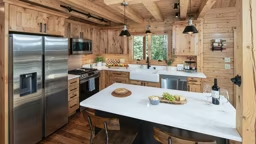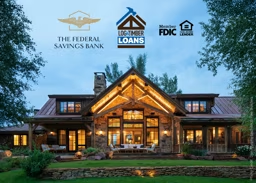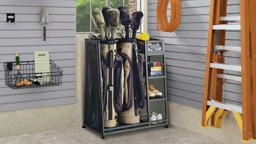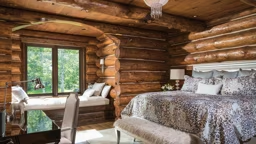 Floor Plan: Courtesy Mountain Log Homes of Colorado
Floor Plan: Courtesy Mountain Log Homes of Colorado
Designing your floor plan is one of the most exciting pieces of the log and timber home puzzle. Many people start by looking at other home plans for inspiration, sketching their ideas and refining them over and over again.
While you’re dreaming and drafting, it’s important to factor some major design points. First, consider the topography of your land, how the home will sit on the site and how you can use your property to your advantage (energy-performance, protection from the elements). Inside, each area of your home will serve a specific purpose, and together these “activity zones” will help dictate its size and shape. Also, think about how you and your family live now, as well as how your needs might change in the future. Combined, these aspects will contribute to how your home will look, flow and function.
Think of your home in four distinct activity zones: working, living, sleeping and garage/storage.
As you plan your activity zones, consider both convenience and practicality. For example, locate the garage close to the kitchen so you don’t have to trek through the house with groceries. The living area should be isolated from the bedrooms so a late-night television watcher won’t keep everyone else awake, and so on.
A poor design could create unnecessary discomfort and extra steps, while a smart design will be a joy to live in for a lifetime.
The Work Zone
 Photo: JK Lawrence
Photo: JK Lawrence
The kitchen, laundry/mudroom and pantry make up the working zone. Modern life tends to be centered around the kitchen, so it should be planned with optimum workflow and entertaining in mind. There are five basic kitchen plans that address its functionality:
The traditional “work triangle” places the sink, stove top and refrigerator in a triangular pattern with equal distance (ideally 5 feet) between each leg, saving steps by making sure you are never very far from preparation, cooking and storage areas. While this has been the benchmark of kitchen planning for decades, it makes the assumption that there’s only one cook in residence, and in today’s households, that’s often not the case.
Zone design, the most recent kitchen configuration on the scene, throws the triangle down the disposal and creates activity zones within this activity zone. Areas for entertaining, plating/serving, cooking and prep work are established, with the respective appliances for each within arm’s reach. Where the triangle’s guiding principle is so that one cook can access multiple areas, the zone system makes way for multiple resident chefs to work side by side without getting in each other’s way.
In terms of layout,
U-shaped and L-shaped spaces offer efficient designs and functionality in open-concept design schemes. Islands work well in either of these configurations, helping cut down the steps necessary in a large kitchen and serving double duty as an entertaining space or extra dining table.
Pullman or galley style kitchens are efficient for one person and are best used in very small homes. It places the fridge, sink, stove and workspace in a linear alignment.
When it comes to
counter space, plan for an overall surface area minimum of 8 to 10 feet. You will need this space to prepare food and at least 18 inches of room on the latch side of the refrigerator so you have a place to set items down when you remove them from the fridge. At the sink, figure 24 inches of space on one side and 36 inches on the other. Plan for 18 inches of space on each side of the range for food prep.
Incorporate a minimum of 18 square feet for general storage, with additional storage space of 6 square feet for each member of the household.
The Living Zone
 Photo: Roger Wade, Courtesy of Hochstetler Milling
Photo: Roger Wade, Courtesy of Hochstetler Milling
This area comprises the living room, dining room and perhaps a family room. The living areas of your log or timber home represent your lifestyle, so ask yourself these valuable questions when planning the important areas:
Is your lifestyle formal or informal? Formal lifestyles dictate a separate living room or dining room, where meals and conversation can be carried on in a dedicated setting. Everyday activities occur in the family room and perhaps a breakfast nook. Informal styles combine the kitchen, living room and eating area into a single space called a great room, with no areas set aside for formal entertaining.
Does your family prefer open space or compartments? A compartmentalized plan closes off rooms from each other by doors and hallways. You can visually separate open living areas with furniture or large archways.
Do you want togetherness or separation for adults and children? Even in an informal, open-space layout, areas can be created to isolate activities from each other. For example, the television can be set off in one section, leaving the remainder of a great room free for other activities.
Where will windows, doors and furniture be? Consider the size and arrangement of your furnishings and make certain that windows and doors are spaced to allow ventilation and illumination, but allow enough wall space for furniture and maneuverability. Knowing approximate furniture locations ahead of time can help in positioning electrical and service outlets for today’s high-tech homes. Cable/satellite television and security systems require special wiring, so to avoid snaking unsightly wires around the room, plan for the location of these things in advance and have the wiring run inside or along the bottom of the walls or even the floor.
The Private Zone
 Photo: Heidi Long / See more of this home here.
Photo: Heidi Long / See more of this home here.
The number of bedrooms and baths depends on the size of your family and the ages of the home’s occupants. For example, you may not want to plan large bedrooms for children who will soon move away, unless they will visit often or live with you while they attend a nearby college. Other considerations include:
Bedrooms.
If you have small children, you will want to locate the master bedroom near the children’s rooms. If your children are older, you may be able to put them in a separate area — upstairs, for example — while keeping the master bedroom downstairs for privacy. (Remember that kids’ bedrooms require flexibility as they grow). If you will have aging parents living with you, a first-floor suite or even a bedroom wing may be a good idea. A guest/spare bedroom can double as a study, eliminating the need to plan a separate home office if you need one.
Bathrooms.
The number of bathrooms and their fixtures will be determined by your needs and budget. Modern emphasis is on convenience and luxury in baths. Freestanding tubs, separate showers, large mirrors, double sinks, saunas, steam rooms and dressing areas are all finding their way into today’s bathrooms.
Most people who are building a custom home want a private bath attached to the master bedroom. You also need to decide if you want each child to have his/her own bath or if they will share one in a central location (maybe even share with guests when they are in residence).
In a multi-use arrangement, you can get clever in terms of design by isolating the toilet in its own water closet or segregating the shower from the sink so that more than one person can use the room at the same time in relative privacy.
The Storage Zone
 Photo: Perry Mastrovito / See more of this home here.
Photo: Perry Mastrovito / See more of this home here.
The final zone consists of garage, utility areas, closets and storage. These areas have a basic set of space rules.
Closets.
Each member of the family should have at least 7 feet of clothes-hanging space. Thoughtfully placed closets cost very little to provide, and they make great sound barriers between bedrooms.
Utility/Laundry.
You can pack a lot of activity in utility and laundry areas if you take location, workflow and traffic patterns into account. These workrooms can serve as a mudroom, hobby room or storage room. You can plan extra counter space for multiple uses and extra storage space.
Equipment Storage.
Take inventory of all your possessions and allocate enough space for them. Don’t forget to include small appliances, sports and recreation gear, hobby equipment, lawn and garden tools, workshop gadgets and exercise machines.
Garage/Driveway.
The layout of your lot will include the driveway, parking spots and space to maneuver cars. Be sure to leave adequate room for boats, ATVs or any other vehicles you have (or are likely to add). Do you want the garage attached to the house or standing alone? Is a carport sufficient? Will there be a breezeway connecting the garage to the house? Garages can be multi-use spaces, too. The washer-dryer, workshop, water heater, furnace, freezer and much of your other daily life necessities can be stored or used in this versatile area.
















